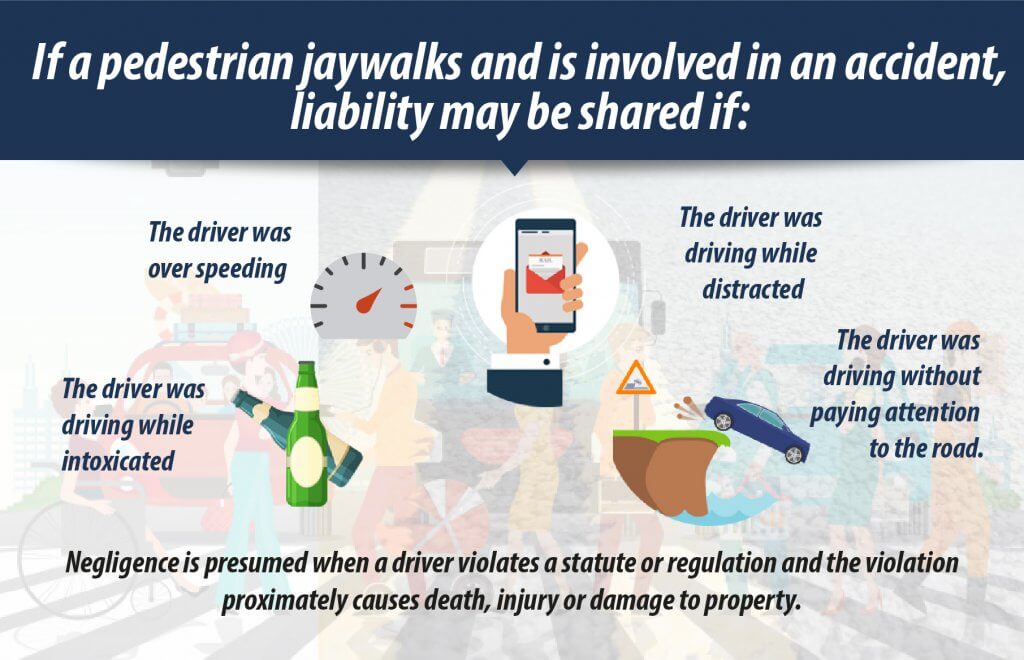Whenever there’s a traffic accident between a pedestrian and a vehicle, the pedestrian will almost always be the one that is most at risk of serious injury or death. Because of this, it’s common to assume that the driver of the vehicle is always at fault for the accident, but this isn’t always the case – especially if the pedestrian was jaywalking or violating some other traffic rule.
What is Jaywalking?
The jaywalking meaning is defined in most jurisdictions as crossing the street or roadway outside a designated crosswalk, or in any other manner that is unlawful, or in violation of traffic laws. In California in particular, this can be a common sight.
Can Drivers Be Held Liable For Hitting a Pedestrian in California Who Is Jaywalking?
The short answer is: sometimes. As a motorist, it can be dangerous to stop in the middle of the road because a pedestrian does not want to walk over to a crosswalk and cross the street in a law-abiding manner. In some cases, pedestrians can be difficult to see until it’s too late. When a pedestrian is injured in an accident while jaywalking, the driver can be liable under certain circumstances.
Do Pedestrians Always Have the Right of Way? Understanding California Pedestrian Road Accidents Laws
Everyone must follow the rules of the road. Both pedestrians and motorists have to exercise due care and caution while on the road. Under the California Vehicle Code section 21950, drivers are to yield the right-of-way to pedestrians crossing on a marked crosswalk or within an unmarked crosswalk at an intersection. A driver approaching a pedestrian on a marked or unmarked crosswalk is expected to reduce speed and take other actions necessary to safeguard the pedestrian.
Do Jaywalkers Have the Right of Way?

Like drivers or cyclists, pedestrians must also obey traffic signals and signage where applicable. It’s against the law for a pedestrian to jaywalk or walk on areas of a highway or road where pedestrian traffic is not permitted. A pedestrian also owes a duty of care not to leave a curb or other safe zone and walk into the path of oncoming vehicles that are so close they would constitute an immediate danger.
What Happens if You Hit a Pedestrian Jaywalking? A Pedestrian’s Legal Obligations and “Shared Fault”
If a pedestrian fails to follow these rules, and that failure plays a part in an accident, the pedestrian will likely be found at least partially at fault. Practically speaking, this means any damages the pedestrian is able to recover (including compensation for injuries) from other at-fault parties may be lowered. The exact role that a pedestrian’s negligence will play in a legal claim will depend on the “shared fault” rules in place where the accident occurred, specifically, whether the state follows contributory or comparative negligence.
Jaywalking and Contributory Negligence
This rule states that an injured person’s negligence in connection with the underlying accident, no matter how slight, will bar the person from any financial recovery from other at-fault parties. For instance, if a pedestrian jaywalked and was then hit by a driver who was speeding, the pedestrian will recover nothing from that driver. This is a very harsh rule and few states apply it (Alabama, Maryland, North Carolina, Virginia, and Washington D.C.).
Jaywalking and Comparative Negligence
Under this rule, the plaintiff’s level of fault determines the total amount he or she can ultimately recover from other at-fault parties. California has a comparative negligence law that determines damages in proportion to one’s fault. This means that a claimant who is 50% at fault for an accident will have damages recoverable lessened by 50%, a claimant who is 20% liable for an accident can recover damages but they will be lessened by 20% and so on.
If a person is injured in an accident while jaywalking and the driver was either over speeding, intoxicated or distracted, then the injured person can claim damages against the driver under California’s comparative negligence laws. Damages awarded will be reduced by the percentage the jury finds the claimant at fault.
There are two variations of comparative negligence and the vast majority of states follow one or the other.
Pure comparative negligence has no fault threshold. As long as the plaintiff wasn’t 100% at fault, they will be able to recover at least something. For example, imagine that a pedestrian walks through an intersection that has posted “no crossing” signs and the pedestrian gets hit by a driver. If a court concludes that the pedestrian is 95% at fault and the pedestrian suffers $100,000 in medical bills, the pedestrian can only legally recover $5,000 from the driver.
Modified comparative negligence first requires that the plaintiff’s level of fault not exceed a certain threshold before the plaintiff can recover anything. Depending on the state, this threshold will often be 50%. So, if the plaintiff is 50.1% (or more) at fault for causing the accident, they recover nothing. But if they’re 50% at fault (or less), they can recover from other parties, though total damages will be reduced by the injured person’s share of fault.

How Does a Pedestrian Injured While Jaywalking Recover Compensation for Accident Injuries?
California law prohibits jaywalking. Pedestrians on a roadway other than a marked crosswalk should yield the right-of-way to oncoming traffic. However, a pedestrian injured by a motorist while jaywalking is not defenseless. The motorist still has a duty to exercise due care even if the pedestrian is outside a demarcated crosswalk.
How an injured pedestrian recovers compensation will depend on who was at fault for the accident and where the accident occurred.
Generally speaking, if the accident occurs in a no-fault car insurance state, either the pedestrian’s or the driver’s own car insurance policy will pay to treat the pedestrian’s injuries, even if the pedestrian was at fault. So, a jaywalking pedestrian can probably get at least one car insurance company to pay for medical bills and certain other economic losses, up to coverage limits. But keep in mind that compensation for pain and suffering and other non-economic losses are not available in a no-fault/PIP claim.
If the accident occurs in a traditional “fault” state, the pedestrian can recover from the other driver by making a third-party car insurance claim under the driver’s liability coverage, but unless the insurer accepts the argument that the driver was totally at fault for the accident, settlement might not be a simple matter. If the pedestrian was completely at fault for the accident, in a “fault state” the pedestrian’s own health insurance policy may be the only avenue of payment for medical treatment.
Hiring the Right Pedestrian Accident Lawyer for Your Case
When injuries are significant and the incident is contentious, it is recommended that injury victims seek an experienced attorney to determine whether a motorist can be held liable for the accident. If you’ve been injured due to the negligence of another individual, Avrek Law may be able to help. With more than 50 years of combined experience in successfully resolving over 10,000 personal injury cases, our attorneys have recovered Over $2 Billion for clients. Contact us today for a free personal injury consultation – we want to hear more about your case!
